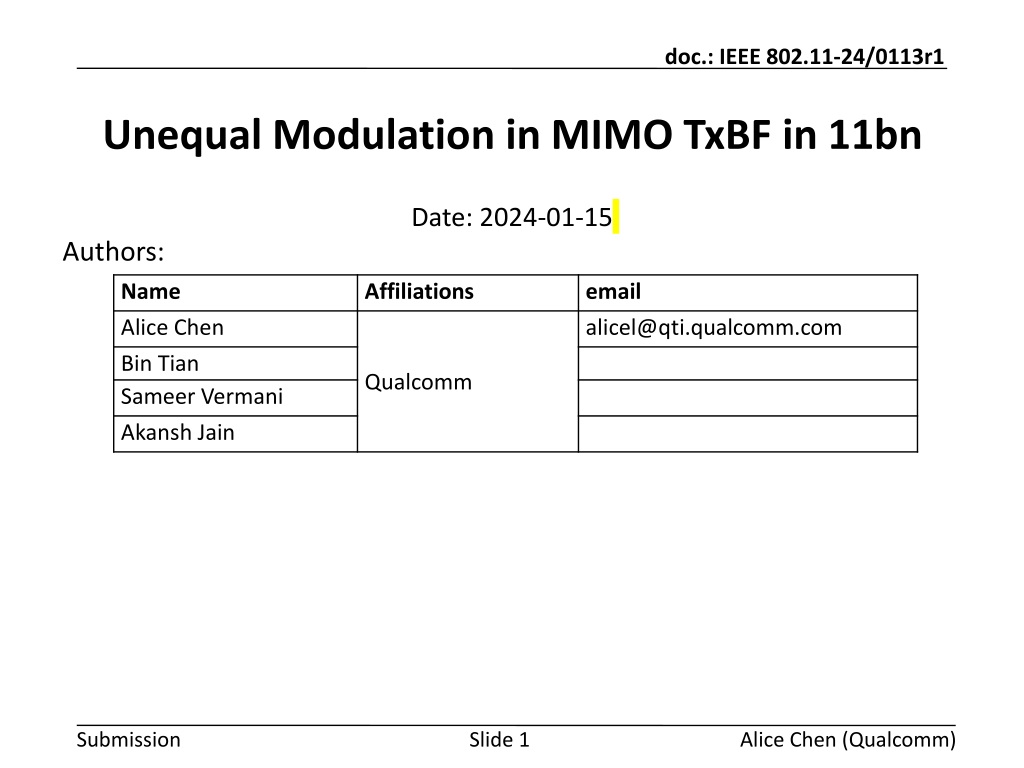

0 likes | 61 Views
The presentation discusses the implementation of unequal modulation in MIMO TxBF systems to optimize channel quality imbalances across spatial streams. A comparison between unequal modulation and unequal MCS methods is made, highlighting the potential gains and benefits of using unequal modulation. Simulation results show significant performance improvements with unequal modulation, especially in scenarios with varying SNRs. The approach of joint encoding with unequal modulation is preferred for multi-stream transmissions, offering lower complexity and higher gains compared to unequal MCS solutions.

E N D
January 2024 doc.: IEEE 802.11-24/0113r1 Unequal Modulation in MIMO TxBF in 11bn Date: 2024-01-15 Authors: Name Alice Chen Bin Tian Sameer Vermani Akansh Jain Affiliations email alicel@qti.qualcomm.com Qualcomm Submission Slide 1 Alice Chen (Qualcomm)
January 2024 doc.: IEEE 802.11-24/0113r1 Introduction • In MIMO beamformed channel, channel quality difference among the eigen modes makes equal MCS across multiple spatial streams sub- optimal • Different proposals were brought up to use different modulations or MCSs in MIMO TxBF, with two flavors • Unequal MCS: With separate encoding of each spatial stream, choose an MCS matched to each spatial stream’s SINR [1-2] • Unequal modulation: With joint coding across streams, choose a QAM modulation matched to each spatial stream’s SINR [3] • In this presentation, we discuss the high level differences between the unequal MCS and unequal modulation and show the potential RvR gain of unequal modulation Submission Slide 2 Alice Chen (Qualcomm)
January 2024 doc.: IEEE 802.11-24/0113r1 Per Stream SNR Gap in 2x2 Channel • Two eigen channels have median SNR gaps of 10.4dB in DNLoS and 11.5dB in BLoS • • Equal MCS in TxBF is not optimal Per stream SNR gap for other antenna configurations are shown in appendix Submission Slide 3 Alice Chen (Qualcomm)
January 2024 doc.: IEEE 802.11-24/0113r1 Unequal Modulation Vs Unequal MCS • Unequal MCS: 2 potential methods of implementation • Method 1: MAC passes down multiple PSDUs to PHY, one PSDU for each stream. Difficult to make them same length • Gain may go away with the inefficiency introduced from padding • Method 2: MAC passes down only 1 PSDU to PHY. Need to use an encoder parser to split PSDU information bit among multiple encoders • There are many different ratios for MCS combinations! Unequal modulation needs one PSDU and uses joint encoding • Potentially better performance since the strong stream can help the weak stream in decoding. We prefer the unequal modulation approach for multiple stream TxBF transmission • • Submission Slide 4 Alice Chen (Qualcomm)
January 2024 doc.: IEEE 802.11-24/0113r1 Simulation Setup • • • • • • • • 20MHz, 2x2x2ss DNLoS & BLoS TxBF (using SVD) with equal power allocation to all spatial streams Linear receiver Candidate code rates: 1/2, 2/3, 3/4, 5/6 Candidate QAM: from BPSK to 1kQAM Genie per channel rate adaptation Different schemes being compared • Equal MCS with existing MCS • Optimum Unequal QAM (any QAM combination for a code rate) • Unequal QAM with existing MCS (both streams use existing MCS from MCS0-11) Submission Slide 5 Alice Chen (Qualcomm)
January 2024 doc.: IEEE 802.11-24/0113r1 2x2x2ss, DNLoS • • Unequal modulation brings significant gain (up to 2.2dB) over wide range of SNR With existing MCS only, unequal QAM doesn’t harvest all the potential gain • At high SNR, unequal QAM uses rates 3/4 and 5/6, which already have good support in existing MCS • At medium SNR, unequal QAM gain may be improved by adding new QAM and code rate combinations Submission Slide 6 Alice Chen (Qualcomm)
January 2024 doc.: IEEE 802.11-24/0113r1 2x2x2ss, BLoS • Similar observation in BLoS Submission Slide 7 Alice Chen (Qualcomm)
January 2024 doc.: IEEE 802.11-24/0113r1 Summary • Proposed unequal modulation with joint encoding for multiple stream TxBF transmission to deal with per spatial stream channel quality imbalance • Lower complexity and potential better gain compared to unequal MCS Gain of unequal modulation may come from two sources • Matching modulation to SINRs of different spatial streams • Finer resolution of data rates from using unequal modulation in different spatial streams Unequal modulation with existing MCS doesn’t harvest all the potential gain • New QAM and code rate combinations may be added to better support unequal modulation • • Submission Slide 8 Alice Chen (Qualcomm)
October 2023 doc.: IEEE 802.11-24/0113r1 SP1 • Do you support to allow unequal modulation with same code rate and joint encoding across multiple spatial streams in TxBF transmission in 802.11bn? • Y • N • A Submission Slide 9 Alice Chen (Qualcomm)
January 2024 doc.: IEEE 802.11-24/0113r1 Reference 1. 2. 3. 11-22/1930r0, Layered QoS and multi-layer transmission 11-22/0060r2, Layered QoS and multi-layer transmission follow-up IEEE 802.11n-2009, IEEE Standard for Information technology-- Local and metropolitan area networks-- Specific requirements-- Part 11: Wireless LAN Medium Access Control (MAC)and Physical Layer (PHY) Specifications Amendment 5: Enhancements for Higher Throughput Submission Slide 10 Alice Chen (Qualcomm)
January 2024 doc.: IEEE 802.11-24/0113r1 Appendix Submission Slide 11 Alice Chen (Qualcomm)
January 2024 doc.: IEEE 802.11-24/0113r1 Per Stream SNR Gaps in 3x3 • In 3x3, eigen channels also have larger SNR gaps Submission Slide 12 Alice Chen (Qualcomm)
January 2024 doc.: IEEE 802.11-24/0113r1 Per Stream SNR Gaps in 4x4 • In 4x4, eigen channels also have larger SNR gaps Submission Slide 13 Alice Chen (Qualcomm)